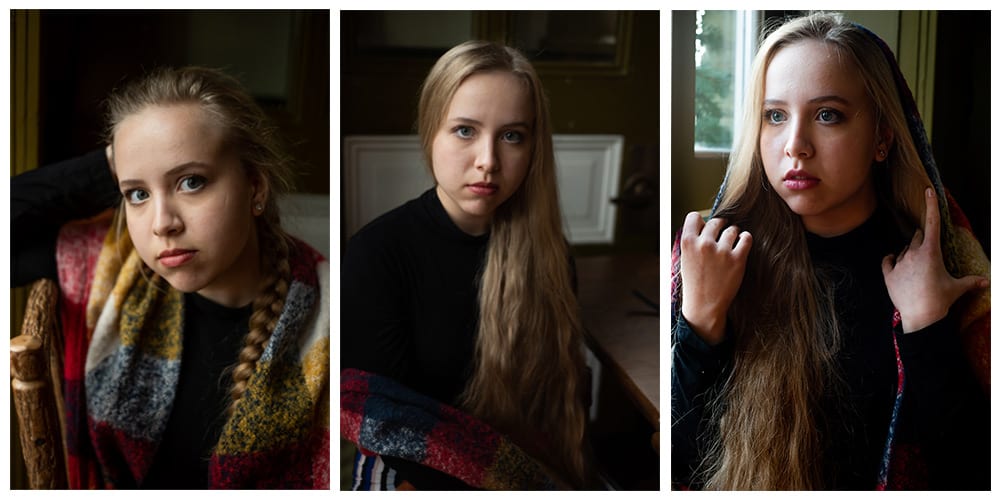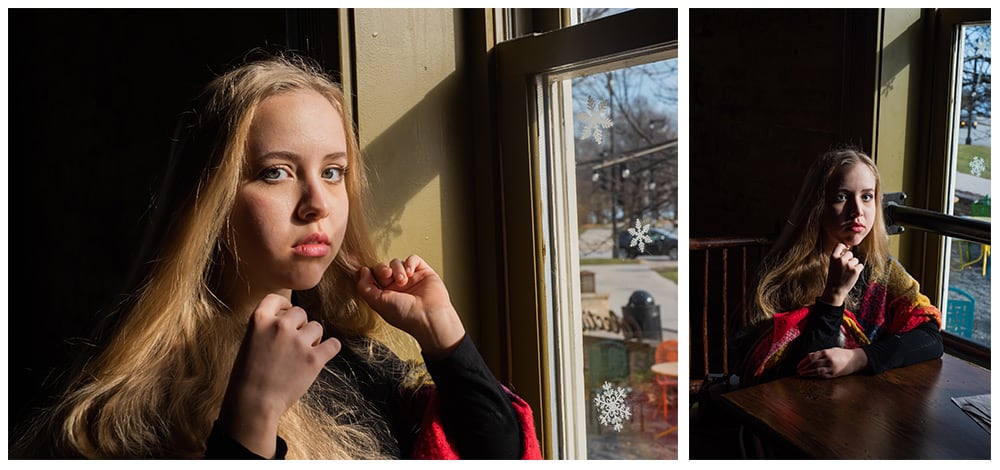
How do I craft well-made expressive portraits? What are my greatest challenges while creating evocative expressive portraits?
While working on strong expressive portraits, I start by putting aside technical photo considerations, such as about technicalities of camera use or studio lights. Not that such skills will not play a part in how I handle the equipment. However, in this instance I first focus on other aspects of photography: especially on how best to reveal an emotional core or emotional essence in the photos I create.
To execute an expressive portrait well, I feel like I must hone the skill of truly “being with” people, even when I just meet them for the very first time. I need to establish closeness with the individuals I photograph. If I’m not shooting indoors, I feel I benefit from the fact that my model or sitter is somewhat removed in space as she/he stands or sits – because that relative distance allows for a more relaxing atmosphere. Despite that relative distance in space, I can and need to become close and intimate with the sitter. I ask myself: how can I approach that person so they can relax, shed their external mask, crawl out of their shell? I usually find that I can do it most easily through individually-fashioned conversation: intuiting what questions I can pose and what questions to avoid.
Doing this well increases the chances of establishing a natural, unfiltered exchange, so my sitters have the opportunity to reveal those aspects of themselves they wish to show to the world. My most challenging task is to intuit the very moment, however fleeting, in which the sitter’s feelings and emotions surface — that is the climax of my session. Although that climax may last just seconds, I must be ready and shoot right then and there — or a good expressive portrait will evade me.
My style of doing photography
When working in the plein-aire or doing so-called “street photography,” I aspire not to stand out, but instead to disappear in the landscape or among others (if people are present). This gets me closer to getting really truly unposed, spontaneous, natural expressive portraits. I try to master the art of camouflage: by wearing unremarkable clothes, keeping a low profile and using a small lens, which I don’t even switch — so I can get lost in the flow of quietly watching, awaiting that special moment for taking the best photos.
Things are different when I work with clients or models in my studio. My models are aware that I am nearby and shooting their photos, so if they are uncomfortable in their role as models, I gently guide them, improve the look of their hair and clothes — through touch as well as words, but only after they consent. I love bringing in an assistant, but only with a sitter’s or client’s consent, of course.
I frequently improvise, chat, and riff with my sitters and clients before I can end up with more uniquely interesting, unposed, spontaneous expressive photos. Let’s say that I like to “go with the flow” when shooting someone.
The most important thing for me is to feel relaxed alongside my sitters/clients, while being “in the moment” with them and sensing their willingness to work with me. I am always flexible with my clients, meaning I encourage and will only use those smiles, smirks, poses etc. that my sitters/clients suggest or agree with. I don’t impose anything of anyone.
On occasion — for which I am prepared, as this is part of life — my interfacing and collaboration with a client will go not smoothly at all, for a number of potential reasons, such as a sleepless night or that the client’s mood if “off.” I see no point in pushing on despite such various obstacles. We will postpone the session to another date, because I want and need my clients to be strong, refreshed, rested. They need to feel at ease, in control, and free to move (or not) as they wish — making it easier for me to focus on capturing that magic moment in which a special expressive portrait can be created.
Perhaps a form of this much-desired ease and control — which results in magical images — is wonderfully described by photographer Eve Arnold in an article about the iconic beauty and actress Marilyn Monroe and her sitting/posing skills: “If an editor wanted her, he had to agree to her terms. She knew how she wanted to be seen, and if her cooperation was sought, she reserved the right of veto. She knew she was superlative at creating still pictures and she loved doing it. She had learned the trick of moving infinitesimally to stay in range, so that the photographer need not refocus but could easily follow movements that were endlessly changing. At first I thought it was surface technique, but it went beyond technique. It didn’t always work, and sometimes she would tire and it was as though her radar failed; but when it did work, it was magic. With her it was never a formula; it was her will, her improvisation.”

